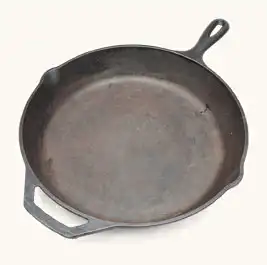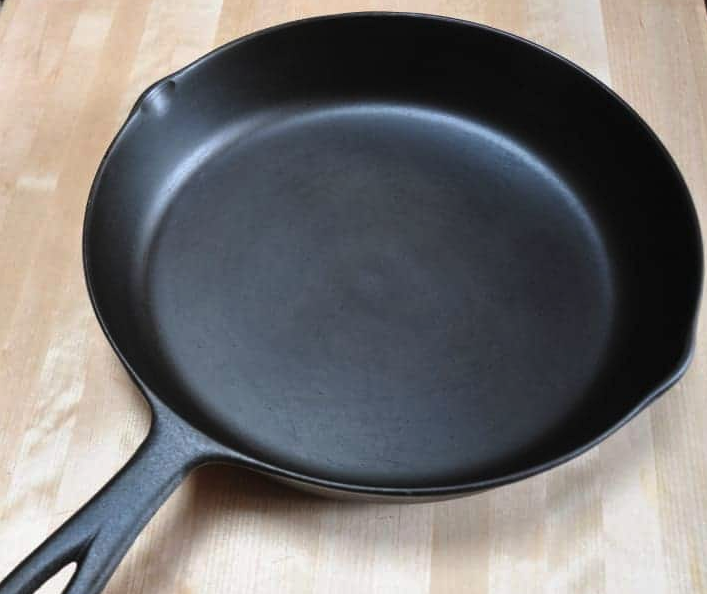How to Season and Maintain a Cast Iron Pan
go.ncsu.edu/readext?916718
en Español / em Português
El inglés es el idioma de control de esta página. En la medida en que haya algún conflicto entre la traducción al inglés y la traducción, el inglés prevalece.
Al hacer clic en el enlace de traducción se activa un servicio de traducción gratuito para convertir la página al español. Al igual que con cualquier traducción por Internet, la conversión no es sensible al contexto y puede que no traduzca el texto en su significado original. NC State Extension no garantiza la exactitud del texto traducido. Por favor, tenga en cuenta que algunas aplicaciones y/o servicios pueden no funcionar como se espera cuando se traducen.
Português
Inglês é o idioma de controle desta página. Na medida que haja algum conflito entre o texto original em Inglês e a tradução, o Inglês prevalece.
Ao clicar no link de tradução, um serviço gratuito de tradução será ativado para converter a página para o Português. Como em qualquer tradução pela internet, a conversão não é sensivel ao contexto e pode não ocorrer a tradução para o significado orginal. O serviço de Extensão da Carolina do Norte (NC State Extension) não garante a exatidão do texto traduzido. Por favor, observe que algumas funções ou serviços podem não funcionar como esperado após a tradução.
English
English is the controlling language of this page. To the extent there is any conflict between the English text and the translation, English controls.
Clicking on the translation link activates a free translation service to convert the page to Spanish. As with any Internet translation, the conversion is not context-sensitive and may not translate the text to its original meaning. NC State Extension does not guarantee the accuracy of the translated text. Please note that some applications and/or services may not function as expected when translated.
Collapse ▲Cast iron makes for a wonderful cooking surface. It’s safe to use, lasts forever, holds heat like nothing else, and is naturally non-stick if it’s properly seasoned. The only downside to cast iron is that it does require a little special maintenance for it to work well, and that can be intimidating to those of us who are used to materials like stainless steel and ceramic. The goal of this article is to demystify the cast iron care process, and hopefully convince you that it is both easy and worth the effort.
Dealing with and Preventing Rust
If improperly seasoned or not fully dried before storage, cast iron can rapidly form a layer of rust that can be difficult to get off. If your cast iron has a small layer of rust, you can probably get it off with a wet towel, some kosher salt (for abrasiveness), and some elbow grease. However, if your cast iron is more rusty, you might need to soak it in vinegar. To do that, you can fully submerge your pan in a solution of a part white water and a part white vinegar. The vinegar will gradually eat away at the rust so that you can easily scrape it off. It is very important not to soak your cast iron in vinegar for longer thatn you need to, so check it every 15 minutes and remove and wash it as soon as the rust is able to flake off. Extreme cases of rust may require sandblasting or other more intensive means of removal. In those cases, I recommend starting over with a new cast iron pan.
Seasoning a Cast Iron Pan
Seasoning cast iron can seem like a confusing and complex process to those unfamiliar with it. However, in reality it is quite easy and straightforward. All we are doing when we season cast iron is coating it in oil and then heating that oil past its smoke point so that it undergoes a chemical reaction to form a water resistant coating on the pan. Take a look at the pictures below for an example. The one on the left is an unseasoned pan. You can easily see the reflective coating (or “seasoning”) that has been applied to the pan on the right via the method described above.
In order to season your cast iron the first step is to ensure that it is both clean and rust free. Since we are about to apply a new seasoning, it is okay to clean it well with soap before this process. But keep in mind that cleaning with soap after this process will remove the seasoning coat and you’ll have to start over. Once your cast iron is clean and dry, follow the steps below to season it:
- Preheat your oven to 550 degrees F.
- Coat your cast iron generously in cooking oil and then wipe off excess so that the pan is coated in a thin layer. You shouldn’t see any oil pooling, just a thin and homogenous layer. You can use any cooking oil you like, but I typically use vegetable oils like olive or canola
- Once your oven has preheated, place your cast iron pan inside and set a timer for an hour. It’s a good idea to turn on your hood vent during this process, since we are intentionally bringing the oil past its smoke point and some fumes will be produced. You should never see flames or heavy smoke from this process since we only use a small layer of oil.
- After an hour, take out your cast iron and let it cool until you can handle it. Then repeat the process exactly as before. Usually, 3 cycles of this will give you a nice seasoning. However, you can do it as many times as you like. Each coat will make the seasoning a bit more thick and shiny.
Each time you cook with your cast iron after your initial seasoning, you will gradually add to the seasoning layer. As long as you are careful not to remove the seasoning layer during cleaning, it can last years before you need to season it again.
Cleaning and Maintaining Cast Iron
When cleaning cast iron you must protect the seasoning layer. To do this, just remember these two things. Don’t use soap (it will remove the seasoning), and don’t use anything too abrasive (like steel wool). The easiest way to clean cast iron is with water and a towel as soon as it’s cooled down enough to handle. The longer you wait after using it, the more difficult it will be to clean. If you have a good seasoning, it is usually no more difficult than a few quick wipes with a towel. Since we are not using soap, there may be a little cooking oil left in the pan after cleaning. As long as it’s just a thin coat and is not enough to pool up, it is perfectly fine to leave it there, and it will even help develop your seasoning further. The most important thing to remember is to never leave any water in or on your cast iron, and NEVER leave it in a wet sink. It will rust very quickly in the presence of water.
That is pretty much all there is to it! There are special tools you can get to make cleaning cast iron easier, but they are not necessary. If you have tough buildup on your pan, you can always boil water in it and scrape with a wooden spoon. That is typically enough for even the dirtiest pans. If the seasoning is starting to look a little worn down, you can rub in a thin layer of oil after cleaning and drying the pan. And if the seasoning is in very bad shape, you can always clean it with soap and apply a brand new seasoning using the method described above.
It may seem like a lot, but once you’ve done these steps and gotten to know your cast iron pan, you’ll start to see why people love them so much! They can last for generations and they work so much better than other materials that the maintenance is well worth it. My favorite part of cast iron is that once you have a good seasoning, they are actually much easier and quicker to clean than other types of pans.






